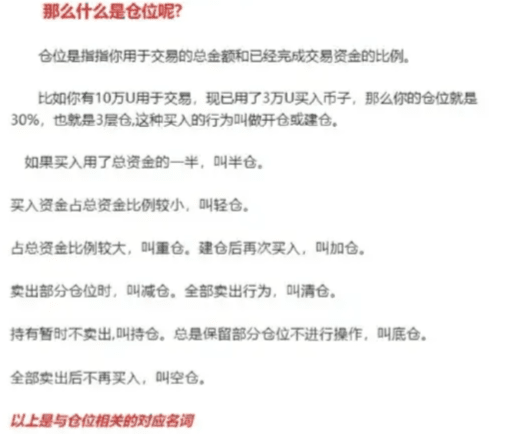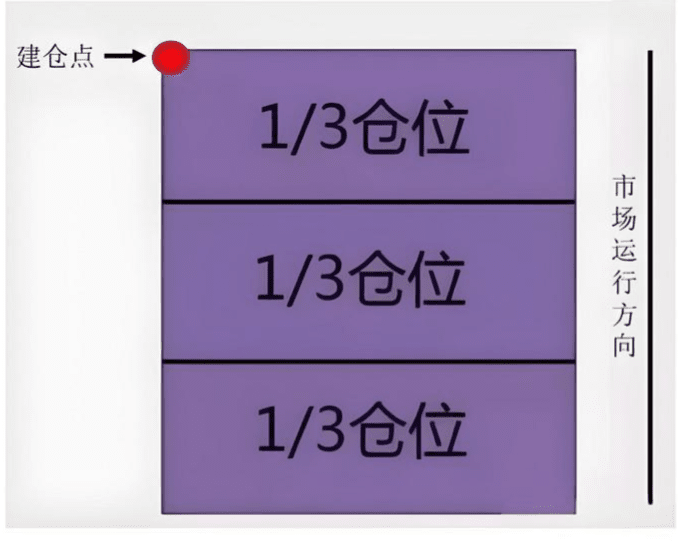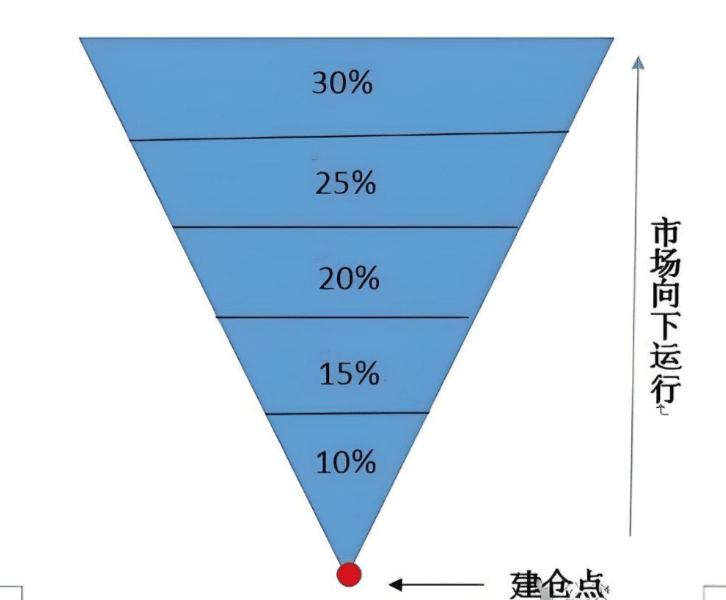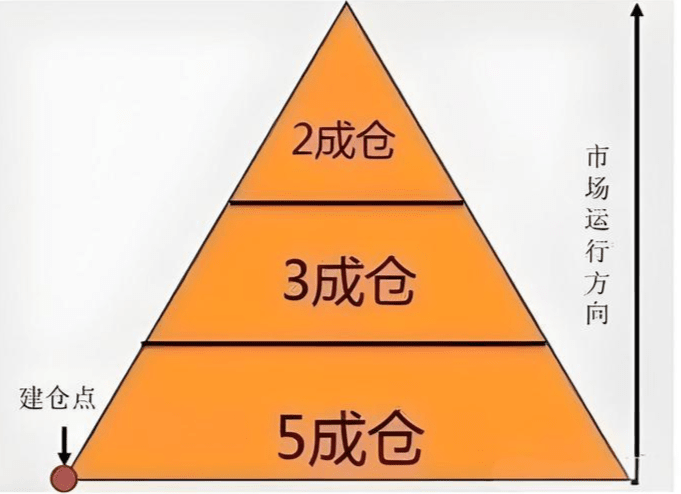In the cryptocurrency world, many people harbor dreams of financial freedom. However, the reality can be harsh; heavy losses often occur with a single drop, while small gains and large losses become the norm. Why do others thrive in the cryptocurrency market while you are always being taken advantage of? In fact, the secret lies in position management.
Position management
Whether in the stock market or cryptocurrency market, doing a good job in position management means you can outperform the vast majority of people.
Regardless of whether it is spot or contracts, how to manage positions directly determines your risk control level, holding average price, and final profit size. This can be said to be the most important point besides direction and mindset.

When trading cryptocurrencies, you need to solve five key questions: What coin to buy, when to buy, how much to buy, when to sell, and how much to sell. Among them, the question of 'how much to buy' seems simple but is actually the core factor determining whether you can profit in the cryptocurrency market. Those who make a fortune in bull markets do not rely solely on luck; position management is their secret to making money.
What is position management?
Position management refers to a specific plan you set for opening positions, increasing positions, decreasing positions, and clearing positions when you decide to trade cryptocurrencies. Good position management is one of our important means to avoid risks, achieving minimal loss and maximum profit!
How should positions be managed? Is there a standard? Many traders fail because one of the key reasons is that they treat market analysis as the entirety of trading, as if analyzing the market alone can determine victory or defeat. In fact, market analysis is only the most basic work; what truly determines victory is what you consider after the analysis, i.e., what you think about after entering the market.

Position management includes capital management and risk control. The term 'position' should not be understood literally; it more expresses when to increase positions, how much to increase, where to decrease positions, and how much to decrease. It is essentially the roadmap for 'entering, increasing, decreasing, and exiting' positions.
Next, I will share three super practical position management methods.
Rectangular position management method: The 'stabilizer' for volatile markets.

This method is very simple; it means dividing your funds into several equal parts. Common splits are into three, five, or even ten parts. Each time, invest the same amount to establish a position. If you are unsure about market trends and do not know whether it will rise or fall next, this method is reliable. In a volatile market, gradually increasing your position in fixed amounts can help you spread out the risk and firmly establish yourself in the cryptocurrency market.
Funnel-type position management method: A must-have 'tool' for bottom-fishing.

Also known as the inverted pyramid management method. Imagine dividing the position from bottom to top into 5 parts, with proportions of 10%, 15%, 20%, 25%, and 30%. If you anticipate a long-term market decline, this method will be useful. When the market starts to decline, enter with a small amount of funds, ensuring you have ample funds to increase your position as the decline continues. Take Bitcoin as an example; if it is currently valued at 65000, set to add 10000 when it drops 10%, 20000 when it drops 20%, and so on, until the market rebounds. However, be careful not to make the intervals between each additional investment too close, or you may run out of funds before the market finds a bottom. This is an excellent method for left-side trading and bottom-fishing, capturing a significant market movement once the bottom is successfully identified.
Pyramid position management method: The 'wealth amplifier' in a bull market.

In contrast to the funnel-type position management method, the pyramid position management method involves investing a large amount of funds at the start and gradually decreasing the proportion of additional investments as the market rises. This method is suitable when the market has already formed an upward trend, i.e., right-side trading. When a bull market arrives, quickly use a large amount of capital to lay the foundation for profits, and then cautiously add more in smaller amounts. An old Wall Street rule states: 'In a bull market, the most important thing is to hold onto your chips until a significant reversal signal appears.' Using this method in a bull market allows you to profit significantly.
Among these three position management methods, there is no absolute good or bad. The market is unpredictable, and you must choose the method that suits you best based on your judgment of the market. Moreover, regardless of which method you use, do not forget to leave a portion of liquid funds in your account, so you can flexibly respond to various situations.
Investing is not just about simple buying and selling; it is actually a reflection of your cognitive ability. Do not always think about going 'full position' to get rich overnight, nor should you always hold a 'light position' and be timid. The truly impressive individuals are those who can manage their positions effectively. Learn to manage your positions, avoid reckless leverage, full positions, or empty positions, bid farewell to being a victim, and start your path to profit in the cryptocurrency world.

Six basic principles of position management:
First: Do not operate in full positions; always maintain a certain proportion of spare funds:
Second: Buying and selling in phases reduces risks, averages costs, and amplifies profits. The advantage of buying in phases when prices decline and selling in phases when prices rise is that your average price will be lower than others, leading to higher profits.
Third: When the market is weak, hold a light position; in a bear market, it is best not to exceed half a position. In a strong market, positions can be moderately increased, with a recommendation of a maximum position of 8 layers in a bull market, leaving 20% as short-term or reserve funds for unexpected occurrences.
Fourth: Adjust positions accordingly as the market changes, appropriately increasing or decreasing positions.
Fifth: When the market is sluggish, it is advisable to keep a short-term empty position and wait for opportunities.
Sixth: Switching positions: Keep strong cryptocurrencies while selling off weak cryptocurrencies.
The above six principles apply to both spot and contracts. If you still don't understand, please read it carefully several times. Reviewing can lead to new understanding, and you can become a teacher!
So, the complete trading process should be:
1. Market analysis, you can use any technical analysis.
2. Position management: After entering, you need to consider what might happen next, such as what to do with profits, whether to increase positions, fully take profits, or continue holding. If profits increase again, what should be done? If losses occur, should you stop-loss, hold on, or partially exit? How much loss would lead to a full exit? Position management considers both risk and reward factors.
3. Strictly implement trades. Once your plan is clear, you must start executing it without letting market fluctuations disrupt your thinking.
4. Summarize trades. After completing a trade, it is necessary to review the previous period of trades. The review should encompass three market states: rising, falling, and volatile. Based on this, improve and optimize market analysis, position management, and the execution process.
First, we must find the entry point based on our trading skills, which certainly aligns with a support line. When the market is above the support line, the trend is upward; when the market falls below the support line, the trend is downward. More importantly, the support line also serves as the basis for defining potential risks. If the stop-loss is placed below this support line, the potential risk level is determined. If it touches the initial stop-loss area below the support line, one should exit first or close most positions and then gradually reduce positions as the decline continues, until all positions are liquidated.
Thus, the potential profit margin is above the support line, indicating that the market's upward trend has not ended. Therefore, theoretically, potential profits are unlimited. After entering, if the price rises, we can hold the original position to wait for further increases or gradually increase positions based on the original position. We will adjust the stop-loss according to market developments. When the market behaves as we expect, we should move the stop-loss closer to the cost price or below a certain margin of the support line. Moving the stop-loss continuously reduces the risk level in the market, effectively locking in floating profits.
When the price rises to a new support or resistance level and then starts to retreat, the area below this support or resistance level becomes the area for reducing positions, and we should gradually liquidate all positions. To summarize: First, we need to find a support-resistance line at the cost price. When the price rises far from the cost line, we gradually increase our position, and the increase must be decreasing. When the price drops further away from the cost line, we gradually reduce our position, which must also be decreasing. Your position management techniques must balance risk and reward.

Next, let's talk about the method of position management, which is phased operations.
Phased operations refer to splitting invested funds for building, increasing, or decreasing positions. Phased operations can be completed in a day or over a period.
Why do we need to take these actions? Because the cryptocurrency market is unpredictable, and both rises and falls are likely events. No one can accurately predict short-term price fluctuations, so we must leave enough funds to cope with unforeseen volatility.
If you operate with a full position without sufficient assurance, once the market changes direction, it can lead to significant losses. Therefore, using a phased approach can reduce the risk of a full position investment, allowing for cost averaging, which is the basis for reducing costs and increasing profits.
Next, let's talk about how to phase: there are equal split phasing and non-equal split phasing.
First: Equal distribution, also known as rectangular trading method, refers to dividing the funds into several equal parts, buying or selling in sequence, with the same proportion of funds for each transaction. Usually, 3 or 4 equal parts are used. For example, first buy 30%, if it starts to profit, buy another 30%. If there is no profit, do not intervene with new funds for the time being. When the price of the cryptocurrency reaches a certain high point or the market changes, gradually reduce the position and sell.
Second: Non-equal distribution, meaning funds are allocated in different proportions for buying or selling, such as ratios of 1:3:5, 1:2:3:4, 3:2:3, etc. The shapes formed by these ratios include diamond, rectangle, hourglass, etc., with the pyramid type being a common trading method.
Third: Use equal funds and positions to compare different methods.
Pyramid: Buy 5 layers at 1000, 3 layers at 1100, 1 layer at 1200, average price 1055.
Inverted pyramid: Buy 1 layer at 1000, 3 layers at 1100, 5 layers at 1200, average price 1144.
Equal rectangular: Buy 3 layers at 1000, 3 layers at 1100, 3 layers at 1200, average price 1100.
When the price rises to 1200, the respective profits are: pyramid 145, inverted pyramid 56, rectangular 100.
When the price drops to 1000, the respective losses are: pyramid +55, inverted pyramid -144, rectangular -100.
Comparing shows that the pyramid type has the least cost, allowing for greater profit when prices rise. When prices fall, it bears more risk. The inverted pyramid is the opposite; if the price falls to 1000, the inverted pyramid loses 144. In actual use, the pyramid method for buying and the inverted pyramid for selling is a more reasonable approach.
After a significant drop in the cryptocurrency price, if we see a bottom but are unsure if it has reached the bottom, buying at this time may lead to being trapped if the price continues to fall. If we do not buy, we worry about missing out on a market rebound. In this case, we can use the pyramid building method.
For example:
When a cryptocurrency falls to a price of 10U, buy a 20% position, and when the price drops to 8U, enter with 30%. At this point, the average cost is 8.6U.
If the market continues to drop to 5U, then enter with 40%, averaging 6.5U.
If the price rebounds to 6.5U, it is considered break-even. If it rebounds to 10U, it means you have made a profit of 3.5U. However, if you buy in full position at 10U, when the price returns to ten dollars, you will only just break even.
During the price increase process, the lower the price, the larger the position you should take when buying; as the price gradually increases, the position should gradually decrease. This method of buying belongs to right-side building. This cost is relatively secure, and even if the market declines, as long as it does not fall below the holding cost, there is no need to panic.
This method requires a high initial position, so it has higher requirements for first-time entrants, needing to have a grasp of market fluctuations, making it suitable for technical players.
The inverted pyramid selling method is the opposite of the regular pyramid; the upper part is broader, and it narrows downwards, resembling a funnel. When the cryptocurrency price rises, the number of coins held decreases gradually, meaning that the number of coins sold increases as the price rises. This is the method for reducing or clearing positions.
The core of position management is the above points. Once you understand them, I believe that in the future, whether it is building positions in spot trading or contracts, you will have a clear thought process.
If you can see this, then I believe you are definitely a loyal fan of the community!
Now let's proceed with practical teaching!
Spot position management
For example: if you have 100000U, you need to split it into ten parts! Prepare to buy ten cryptocurrencies! Allocate 10000U for each cryptocurrency! Each time you enter, you invest the same amount!
For example: Building a position for XX cryptocurrency, XX price at 50% position, and XX price topping up at 50% position. The meaning of 50% position is to allocate a standard of 10000U for each coin, using 5000U for building a position and reserving 5000U for topping up.
In spot trading, the principle is: heavy positions on coins you are confident in, and light positions on those you are not!
This cryptocurrency is good, so I will buy more, purchasing 30000U.
This cryptocurrency is average, so I will buy about 10000U.
If you do not follow this position, then a problem will occur: if you buy 30000U of a cryptocurrency heavily and lose 10%, that's 3000U. Meanwhile, if you lightly buy 10000U of another cryptocurrency and it rises 10%, you only gain 1000U, and you are still at a loss!
This is the straightforward operation for spot trading; if you don’t understand, read it a few more times.
Contract position management
ETH position allocation, calculated by the number of units!
The maximum position for 1000u principal cannot exceed 5 units.
The maximum position for 3000u principal cannot exceed 10 units.
The maximum position for 5000u principal cannot exceed 20 units.
The maximum position for 10000u principal cannot exceed 30 units.
The maximum position for 30000u principal cannot exceed 50 units.
The maximum position for 50000u principal cannot exceed 100 units.
BTC position allocation, calculated by the number of units!
The maximum position for 1000u principal cannot exceed 0.5 units.
The maximum position for 3000u principal cannot exceed 1 unit.
The maximum position for 5000u principal cannot exceed 2 units.
The maximum position for 10000u principal cannot exceed 3 units.
The maximum position for 30000u principal cannot exceed 5 units.
The maximum position for 50000u principal cannot exceed 10 units.
Contracts are essentially the same as spots; the initial capital for each order is the same, and the number of units per order is the same. You should take profits when needed and cut losses when necessary, treating yourself as a trading machine! In the end, K will conquer you with strength!

Finally, let me share a few personal suggestions for making good trades.
First: Technical aspects, including technical indicators, candlestick patterns, trading volume, trend judgment, distinguishing between bull and bear markets, identifying buying and selling points, judging support and resistance, and utilizing volume-price-time-space.
This varies from person to person; some may not understand technology and have no interest, and there is nothing to be done about that.
Second: Fundamental analysis, including relevant macroeconomic factors, policies, regulations, and the project itself.
Third: News factors, both negative and positive news, should be operated on in the context of good news and fundamentals.
Fourth: Time cycles, intraday short-term, medium-short-term, medium-long-term, long-term (trend trading). Confirm the trading cycle to achieve consistency with the operation cycle. For example, in long-term trading, do not frequently conduct short-term buying and selling operations. During long-term trends, intermediate adjustments and fluctuations can be accepted as long as there is enough space, and the cryptocurrencies are mainstream ones, as prices will rise again.
Fifth: Mindset control, remember not to fluctuate too much. Once a plan is made, implement it without hesitation.
Sixth: Strict stop-loss, stop-loss is the worst-case scenario. When the market reverses, do not hesitate to stop-loss and escape the peak.
The old expert only does actual trading; the team still has positions available for entry.


